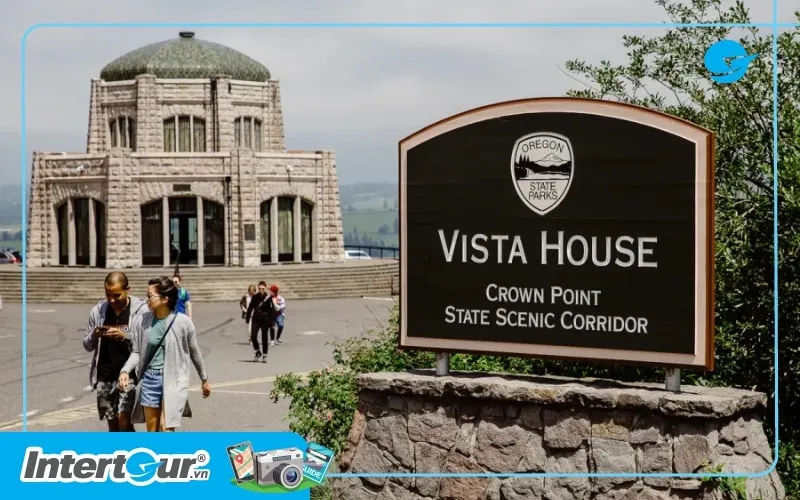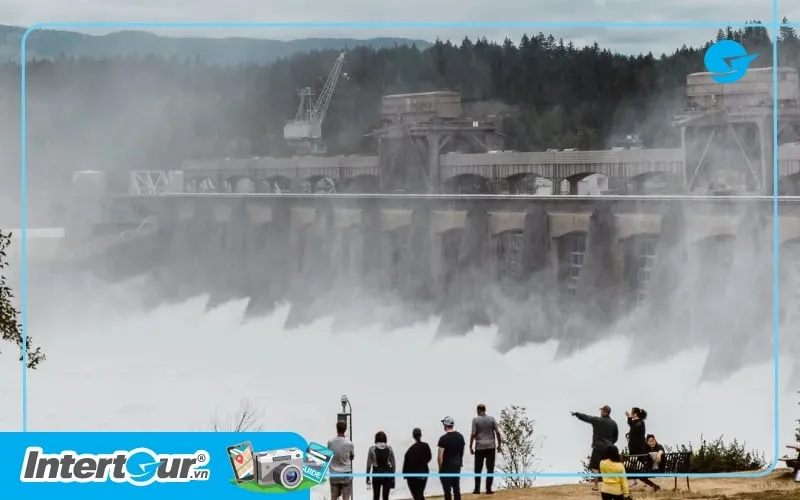If you’re searching for a destination that is both majestic and poetic, filled with fascinating things to explore, then the Columbia River Gorge is the jewel of Oregon you can’t miss. Designated a National Scenic Area, this gorge is not only a unique geological wonder but also a paradise for adventure travelers, nature lovers, and those interested in the history and culture of the American Northwest. Let “Du lịch khắp thế gian” (Travel the World) guide you on a journey to discover the Columbia River Gorge, where natural beauty blends with unforgettable experiences awaiting you.
Introducing the Columbia River Gorge: A Grand Symphony of Nature
The Columbia River Gorge is more than just a canyon; it’s a magnificent work of art sculpted by the forces of nature over millions of years. Formed by Ice Age floods approximately 14,000 years ago, this gorge is a powerful testament to Earth’s constant transformation. The Missoula Floods, with their immense destructive power, carved through western Oregon, creating a gorge over 4,000 feet deep and 80 miles long, stretching from the outskirts of Portland to the town of The Dalles.
The Columbia River Gorge is not only impressive in size but also in its astonishingly diverse landscapes. Exploring the gorge will take you through lush temperate rainforests, where waterfalls cascade down moss-covered cliffs, to arid lands with a semi-desert climate, where summer temperatures can reach 100 degrees Fahrenheit (38 degrees Celsius). This contrast creates a unique natural tapestry, unparalleled in its kind.
Due to its unique geographical location, the Columbia River Gorge acts as a natural corridor, connecting the wet coastal region of the Pacific with the dry inland. This climatic intersection has created a rich ecosystem, one of the most biodiverse in North America. It’s not only home to countless species of flora and fauna but also an ideal destination for outdoor activities such as trekking, rock climbing, kayaking, cycling, and camping.
Since 1986, the Columbia River Gorge has been recognized by the U.S. federal government as a National Scenic Area, affirming the immense natural, cultural, and historical value of this region. It’s not just a source of pride for Oregonians but also a captivating destination for travelers from around the world who yearn to conquer nature and enjoy unparalleled breathtaking scenery.
The Best Time to Explore the Columbia River Gorge
The best time to explore the Columbia River Gorge depends on your personal preferences and desired experiences. Each season, the gorge dons a distinct beauty, offering different travel experiences.
Spring (March – May): This is when the Columbia River Gorge is full of life. As snow melts on the mountaintops, over 90 waterfalls in the area awaken simultaneously, creating spectacular water displays. The vegetation also revives after winter, displaying vibrant wildflowers across the mountainsides and meadows. Spring is the perfect choice for those who love the fresh, energetic beauty of nature and want to admire the most magnificent waterfalls.
Summer (June – August): Summer is ideal for outdoor activities in the Columbia River Gorge. Warm, dry, and sunny weather creates favorable conditions for trekking, hiking, kayaking, SUP, cycling, and rock climbing. This is also the peak tourist season, with many festivals and events taking place in the area. If you want to enjoy a lively atmosphere and participate in water sports, summer is the time to go.
Autumn (September – November): As the autumn winds begin to blow, the Columbia River Gorge transforms into a charming autumn spectacle. Maple, oak, and other deciduous trees simultaneously change colors, creating a vibrant landscape painting with shades of yellow, orange, and red. Autumn is perfect for leisurely hikes, admiring the romantic scenery, and enjoying the fresh, cool air. This is also the harvest season for the famous apples and pears of the Hood River region; you can visit orchards and enjoy fresh fruit.
Winter (December – February): Winter is the quietest season in the Columbia River Gorge, but no less attractive. The winter scenery offers a tranquil, peaceful, and somewhat mysterious beauty. Light rain and fog create a romantic atmosphere, while snowfall blankets the mountaintops and forests, turning the gorge into a winter wonderland. Winter is suitable for those seeking tranquility, relaxation, and admiring the unique beauty of the gorge in winter.
Top Must-Visit Destinations in the Columbia River Gorge
The Columbia River Gorge boasts countless attractions, from historical architectural landmarks to magnificent natural wonders. Here are some notable destinations you shouldn’t miss on your journey of discovery:
Crown Point Vista House: A Historic Observatory

Crown Point Vista House is a unique architectural structure perched atop Crown Point, a basalt promontory jutting out from the gorge wall, offering panoramic views of the entire Columbia River Gorge. Built in 1918 in the Art Nouveau style, Vista House is not only a stunning observatory but also a small museum showcasing the history and geology of the area. From here, you can admire the Columbia River winding like a soft silk ribbon, the rolling green mountains, and the vast, boundless sky. Vista House is an ideal starting point to begin your gorge exploration and take in the entire majestic beauty of this place.
Multnomah Falls: Oregon’s Tallest Waterfall
Multnomah Falls is one of Oregon’s most famous natural icons and the tallest waterfall in the state, with a total height of 620 feet (189 meters). Water from Larch Mountain stream cascades down two tiers, creating a spectacular and captivating scene. Benson Bridge, a graceful stone bridge spanning the second tier, is an ideal vantage point to admire the full beauty of Multnomah Falls and capture wonderful souvenir photos. The trail leading to the top of the falls will take you to another viewpoint, where you can gaze down at the waterfall from above and look out over the panoramic gorge landscape.
Hood River: A Watersports Paradise
Hood River is a charming small town located along the banks of the Columbia River, famous as the “Windsurfing Capital of the World.” Thanks to its unique geographical location and strong winds year-round, Hood River has become an ideal destination for water sports such as windsurfing, kitesurfing, kayaking, and SUP. If you love thrilling sensations and want to try adventurous sports, Hood River will certainly not disappoint. In addition, the town has many cafes, restaurants, and sports shops, creating a vibrant and youthful atmosphere.
Bonneville Dam: An Engineering Marvel and Salmon Migration

Bonneville Dam is a massive hydroelectric dam built on the Columbia River, about 40 miles (64 km) east of Portland. It’s not only an impressive engineering marvel but also a great observation point to witness the salmon migration phenomenon. Each year, millions of salmon swim upstream the Columbia River to return to their spawning grounds, overcoming rapids and obstacles along the way. At Bonneville Dam, you can visit the fish ladders specially designed to help salmon bypass the dam and observe this incredible migration process up close. The Bonneville Dam Visitor Center also provides a wealth of interesting information about the history, engineering, and environment of the area.
Unique Experiences in the Columbia River Gorge
Besides visiting famous destinations, the Columbia River Gorge offers countless unique and memorable experiences:
Trekking and Hiking: With hundreds of miles of hiking trails, the Columbia River Gorge is a paradise for trekking and hiking enthusiasts. The trails vary in difficulty, from easy to challenging, suitable for all fitness levels and preferences. You can choose short, easy trails to see waterfalls and wildflowers, or challenge yourself with longer trails, climbing to mountaintops to admire panoramic views of the majestic gorge.
Kayaking and SUP: The Columbia River and lakes in the area are ideal locations for kayaking and SUP (stand-up paddleboarding). You can rent boats in riverside towns and freely explore the beauty of the gorge from the water. Paddling on the Columbia River is an exciting experience, allowing you to get closer to unspoiled nature and enjoy the fresh, cool air.
Long-Distance Cycling: The Historic Columbia River Highway, Scenic Byway 30, and other bike trails in the area are excellent choices for long-distance cycling trips. You can cycle along the Columbia River, admire waterfalls, forests, and quaint villages, or conquer steep passes to challenge your endurance and enjoy the feeling of accomplishment.
Birdwatching and Wildlife Viewing: The Columbia River Gorge is one of the most biodiverse areas in North America, home to hundreds of species of birds and wildlife. You can join eco-tours to birdwatch, observe wildlife such as deer, elk, squirrels, foxes, and raccoons in their natural habitat. Spring and autumn are the best times for migratory birdwatching.
Travel Tips and Advice for the Columbia River Gorge
To have a complete and memorable exploration of the Columbia River Gorge, keep in mind these travel tips and advice:
- Prepare Clothing and Gear: Bring comfortable, breathable, and sweat-wicking clothing, hiking boots or sports shoes, a hat, sunglasses, sunscreen, and a light jacket, especially if you go in spring or autumn. Don’t forget to bring drinking water, snacks, and a travel map.
- Choose Accommodation: There are many accommodation options in the towns surrounding the Columbia River Gorge, from luxury hotels and budget motels to campsites. If you want to stay close to the main attractions, choose hotels in Hood River, Cascade Locks, or The Dalles. If you enjoy camping, there are many beautiful and well-equipped campsites in the National Scenic Area.
- Transportation: Renting a car is the most convenient way to explore the Columbia River Gorge, allowing you to freely move between attractions and discover lesser-known spots. Alternatively, you can use buses or join organized tours to get around the area.
- Local Cuisine: Don’t miss the opportunity to enjoy local cuisine in the Columbia River Gorge. This region is famous for fresh fruit, especially apples and pears from the Hood River Valley. You can also enjoy fresh seafood, grilled meats, and local wines at restaurants and eateries in the area.
Conclusion: Discovering the Columbia River Gorge – An Unforgettable Journey
The Columbia River Gorge is not just a tourist destination; it’s an emotional journey of discovery, bringing you closer to majestic nature and the unique cultural and historical values of the American Northwest. From roaring waterfalls and lush forests to ancient architectural landmarks and adventurous sports experiences, the Columbia River Gorge promises to give you unforgettable memories and deep impressions of the endless beauty of Earth. Plan your trip today and get ready to explore this amazing natural wonder!